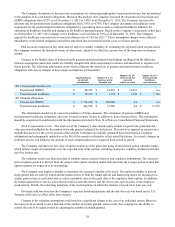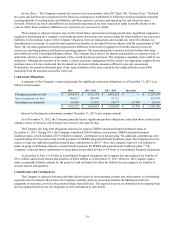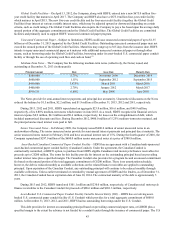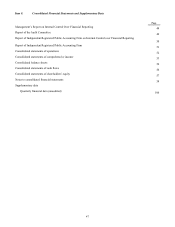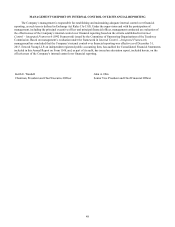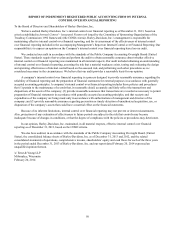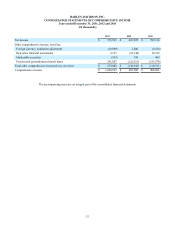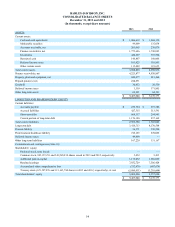Harley Davidson 2013 Annual Report Download - page 45
Download and view the complete annual report
Please find page 45 of the 2013 Harley Davidson annual report below. You can navigate through the pages in the report by either clicking on the pages listed below, or by using the keyword search tool below to find specific information within the annual report.45
• incur certain additional indebtedness;
• assume or incur certain liens;
• participate in certain mergers, consolidations, liquidations or dissolutions; and
• purchase or hold margin stock.
Under the financial covenants of the Global Credit Facilities, the consolidated debt to equity ratio of HDFS cannot exceed
10.0 to 1.0. In addition, the Company must maintain a minimum interest coverage ratio of at least 2.25 to 1.0 for each fiscal
quarter through June 2013 and at least 2.5 to 1.0 for each fiscal quarter thereafter. No financial covenants are required under the
Notes or the U.S. or Canadian asset-backed commercial paper conduit facilities.
At December 31, 2013, 2012 and 2011, HDFS and the Company remained in compliance with all of the existing
covenants.
Cautionary Statements
The Company’s ability to meet the targets and expectations noted depends upon, among other factors, the Company’s
ability to:
(i) execute its business strategy,
(ii) adjust to fluctuations in foreign currency exchange rates, interest rates and commodity prices,
(iii) manage through inconsistent economic conditions, including changing capital, credit and retail markets,
(iv) manage through the effects inconsistent and unpredictable weather patterns may have on retail sales of
motorcycles,
(v) implement and manage enterprise-wide information technology solutions, including solutions at its
manufacturing facilities, and secure data contained in those systems,
(vi) anticipate the level of consumer confidence in the economy,
(vii) continue to realize production efficiencies at its production facilities and manage operating costs including
materials, labor and overhead,
(viii) manage production capacity and production changes,
(ix) manage changes and prepare for requirements in legislative and regulatory environments for its products,
services and operations,
(x) provide products, services and experiences that are successful in the marketplace,
(xi) manage risks that arise through expanding international marketing, operations and sales,
(xii) manage the credit quality, the loan servicing and collection activities, and the recovery rates of HDFS’ loan
portfolio,
(xiii) continue to manage the relationships and agreements that it has with its labor unions to help drive long-term
competitiveness,
(xiv) manage supply chain issues, including any unexpected interruptions or price increases caused by raw material
shortages or natural disasters,
(xv) develop and implement sales and marketing plans that retain existing retail customers and attract new retail
customers in an increasingly competitive marketplace,
(xvi) adjust to healthcare inflation and reform, pension reform and tax changes,
(xvii) retain and attract talented employees,
(xviii) manage the risks that the Company's independent dealers may have difficulty obtaining capital and managing
through changing economic conditions and consumer demand,
(xix) continue to have access to reliable sources of capital funding and adjust to fluctuations in the cost of capital,
(xx) continue to develop the capabilities of its distributor and dealer network, and
(xxi) detect any issues with the Company's motorcycles or manufacturing processes to avoid delays in new model
launches, recall campaigns, increased warranty costs or litigation.





